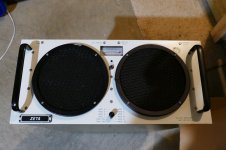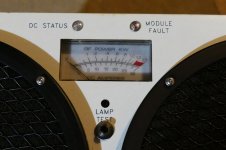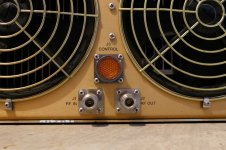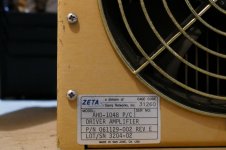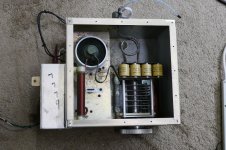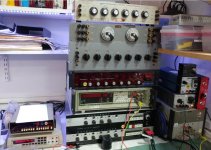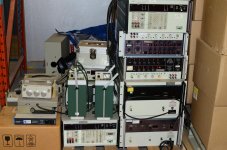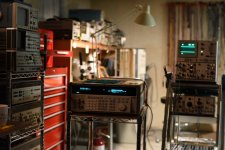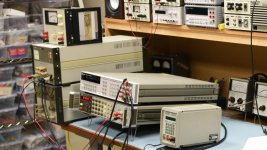Fully fitted out and worked over by the guys at AP. SYS2722 192k -- last calibrated 4 years ago.
Both of my workbenches are in a state of redesign. One was dedicated to vacuum tube stuff with it's large space, high weight capability and high voltage power supplies. The other was used for small low powered stuff like a music synthesizer project, powered by an Arduino compatible board with several analog modules. I have collected a good bit of RF test equipment with the idea of recreating my setup that I used at Motorola for RF design work. The RF equipment has been stacked up in a rack, and mostly unused, but an RF contract job has come my way forcing me to accelerate the building of the Motorola workbench clone. I am stripping both benches and rearranging the workspace so that I can fit a third bench in. I need to do RF stuff from the "heavy metal" bench as well as the "small stuff" bench. Why?
Here are pictures of a little toy I acquired on "black Friday." Definitely in the "heavy metal" category since it took three of us to get it down here into the basement. It's rack mount 5 RU tall by 24 inches deep. My guess is over 100 Lbs. What is it? I don't know exactly but it puts out over a kilowatt of RF power from 400 to 450 MHz. 432 EME anyone?
Here are pictures of a little toy I acquired on "black Friday." Definitely in the "heavy metal" category since it took three of us to get it down here into the basement. It's rack mount 5 RU tall by 24 inches deep. My guess is over 100 Lbs. What is it? I don't know exactly but it puts out over a kilowatt of RF power from 400 to 450 MHz. 432 EME anyone?
Attachments
Hi George,
Well, it says that it is a driver amplifier. My guess is that it drives a huge final RF amplifier.
How close was I?
-Chris
Well, it says that it is a driver amplifier. My guess is that it drives a huge final RF amplifier.
How close was I?
-Chris
Hi Jack,
Excellent!!! Just what the doctor ordered! I can't thank you enough for those.
Best, Chris
Excellent!!! Just what the doctor ordered! I can't thank you enough for those.
Best, Chris
Here are pictures of a little toy I acquired on "black Friday." Definitely in the "heavy metal" category since it took three of us to get it down here into the basement. It's rack mount 5 RU tall by 24 inches deep. My guess is over 100 Lbs. What is it? I don't know exactly but it puts out over a kilowatt of RF power from 400 to 450 MHz. 432 EME anyone?
You'll be the one who takes the Fluke 5205A amplifier -- free for the shipping. I'd drag it to Ohio, but can't lift it into the Ford Expedition without one of my sons present.
Hi Jack,
That's a cool piece of gear. Which calibrator was it designed to work with? 5700A?
-Chris
That's a cool piece of gear. Which calibrator was it designed to work with? 5700A?
-Chris
You'll be the one who takes the Fluke 5205A amplifier
I used to collect just about anything electronic if it was free or very cheap, then Sherri lost her job managing a warehouse complex and the cheap rent went away. This was about the same time that my parents and her mother left this world and we had to clean out two houses. Shortly after that I came to realize that my career was on life support and a big move was in the near future. We realized that both of us had collected enough "stuff" for several lifetimes, so we decided to downsize.....bigtime. We sold, gave away, or flat out trashed most of our "stuff" and eventually moved everything that we kept 1200 miles north.
At this point in my life I try not to collect any more "stuff" that I may never use. The UHF kilowatt amp was free, and probably an iffy project, but I may actually put it on the air someday if it turns out to be linear enough for SSB. If not I'll drag it to Dayton and sell it. I left the water cooled 10 KW HF ISM amp behind. It was bigger, and two large boat anchors would trip the WAF breaker.....bigtime! Still another funny looking box with a large ceramic tube and a PI network found its way into the back of the car.
What would I do with an amp that makes +/- 1200 volts at 200 mA? I don't know.
My guess is that it drives a huge final RF amplifier. How close was I?
I don't really know myself. My friend was a military surplus dealer. He got a bunch of this stuff in s few years ago. There were three of these, one somewhat disassembled. These were all part of some large mobile system that was truck mounted.
The partially disassembled unit contained 11 identical modules arranged on heat sinks. It appeared from the pictures he sent me at the time that one module drove the other ten through a power splitter and the ten outputs were then combined. He sent me one of the modules and I fired it up. It needs 26 or 28 volts and puts out about 130 watts at P1dB with 10 watts of drive. It made good power from 390 to 460 MHz.
If the driver puts out a kilowatt, what does the output stage do?
Attachments
What would I do with an amp that makes +/- 1200 volts at 200 mA? I don't know.
Stax electrostatic headphones?
Hi George,
If I had a 5700 calibrator, I would definitely want it. Given a choice I would rather have a 5500A or 5520A calibrator. Those are all old instruments by now, but I still would like to calibrate my own gear, and a 5520A also does oscilloscopes
Anyone else want to set up a calibration lab?
-Chris
Pretty much whatever it wants I would guess. It would be excellent for dimming the lights while cooking dinner.If the driver puts out a kilowatt, what does the output stage do?
If I had a 5700 calibrator, I would definitely want it. Given a choice I would rather have a 5500A or 5520A calibrator. Those are all old instruments by now, but I still would like to calibrate my own gear, and a 5520A also does oscilloscopes
Anyone else want to set up a calibration lab?
-Chris
Cal Lab
Someone mentioned cal lab? Here is my setup.
From bottom to top-
Optimation AC110 absolute AC calibrator
Fluke 8506A
Valhalla 2701 DC calibrator
ESI RV722 Kelvin Varley divider
ESI Lead compensator
Dytronics high frequency ratio transformer
Next pile
Fluke 732A DC reference
HP 735 DC reference
Fluke 731B DC reference
Vahalla 100:1 divider for the DC calibrator
Quantasylum QA350 QA350 Microvolt DC Volt Meter – QuantAsylum (a real value)
Not in the picture (no space)
JRL 7 digit KV divider
JRL Voltavider (for millivolts etc. )
High voltage amp for the Optimation (110V RMS to 1 MHz)
Low frequency ratio transformer
Fluke 540B thermal transfer standard
various thermal converters
Arbiter GPSDO for frequency (10 MHz, 5 MHz 1 MHz Wenzel OXCO source disciplined by satellite)
ESI and JRL resistance boxes (.02% and .01%)
GR decade capacitance box
Various resistance, capacitance and inductance standards
All because I did not want to pay for calibration. Downside- keeping all this stuff healthy is a major chore. at least i'm pretty confident about voltage, resistance and frequency. Upside, this is a world where facts are real and BS walks. E.G. copper to copper connections- yes for DC, irrelevant for AC. Thermals from dissimilar metals easy to see. Losses in cables and connections at AC easy to see but at .0001 dB do they matter? At least I can be pretty confident of frequency response.
When I got this stuff no one wanted it and nothing was more than $300 and most was more like $30. Now there are fellow denizens of the asylum looking at all of this stuff.
edit: Forgot to mention the Vahalla and the Prema DVMs lower left.
Someone mentioned cal lab? Here is my setup.
From bottom to top-
Optimation AC110 absolute AC calibrator
Fluke 8506A
Valhalla 2701 DC calibrator
ESI RV722 Kelvin Varley divider
ESI Lead compensator
Dytronics high frequency ratio transformer
Next pile
Fluke 732A DC reference
HP 735 DC reference
Fluke 731B DC reference
Vahalla 100:1 divider for the DC calibrator
Quantasylum QA350 QA350 Microvolt DC Volt Meter – QuantAsylum (a real value)
Not in the picture (no space)
JRL 7 digit KV divider
JRL Voltavider (for millivolts etc. )
High voltage amp for the Optimation (110V RMS to 1 MHz)
Low frequency ratio transformer
Fluke 540B thermal transfer standard
various thermal converters
Arbiter GPSDO for frequency (10 MHz, 5 MHz 1 MHz Wenzel OXCO source disciplined by satellite)
ESI and JRL resistance boxes (.02% and .01%)
GR decade capacitance box
Various resistance, capacitance and inductance standards
All because I did not want to pay for calibration. Downside- keeping all this stuff healthy is a major chore. at least i'm pretty confident about voltage, resistance and frequency. Upside, this is a world where facts are real and BS walks. E.G. copper to copper connections- yes for DC, irrelevant for AC. Thermals from dissimilar metals easy to see. Losses in cables and connections at AC easy to see but at .0001 dB do they matter? At least I can be pretty confident of frequency response.
When I got this stuff no one wanted it and nothing was more than $300 and most was more like $30. Now there are fellow denizens of the asylum looking at all of this stuff.
edit: Forgot to mention the Vahalla and the Prema DVMs lower left.
Attachments
Last edited:
What would I do with an amp that makes +/- 1200 volts at 200 mA? I don't know.
Get 3 more and drive your esl's directly. Have some imagination guys! ;-)
Jan
Hi Murray,
I wish I had known. I could have saved at least a couple pieces.
I am familiar with your equipment, having used that stuff at work (Transcat). Absolutely wonderful to have your own cal lab.
Hi Demian,
Ditto, but Murray's is easier to use.
All I have is a GPS disciplined oscillator (10 MHz). When I get my GPS panel I will also have 5 MHz, 10 MHz and 15 MHz. My standard for voltage would be an HP3457A and a Vahalla 8200. I also have an RFL 828 calibrator (3 1/2 digit at best) that I use with a meter as a transfer standard.
-Chris
I wish I had known. I could have saved at least a couple pieces.
I am familiar with your equipment, having used that stuff at work (Transcat). Absolutely wonderful to have your own cal lab.
Hi Demian,
Ditto, but Murray's is easier to use.
All I have is a GPS disciplined oscillator (10 MHz). When I get my GPS panel I will also have 5 MHz, 10 MHz and 15 MHz. My standard for voltage would be an HP3457A and a Vahalla 8200. I also have an RFL 828 calibrator (3 1/2 digit at best) that I use with a meter as a transfer standard.
-Chris
What no one else has a pistonphone? I actually got a standard cell, ratiometer and optical galvanometer. Navy surplus for $5.
Now these days for DC you can buy band gap references that are better than a standard cell.
Now these days for DC you can buy band gap references that are better than a standard cell.
I have 3 pistonphones. And a GR Reciprocity Calibrator. That stuff is for a different list. . .
The band gaps are good but buried zener is still the best option short of a JJ. And its all still way overkill.
The band gaps are good but buried zener is still the best option short of a JJ. And its all still way overkill.
- Home
- Design & Build
- Equipment & Tools
- What's on your workbench???
